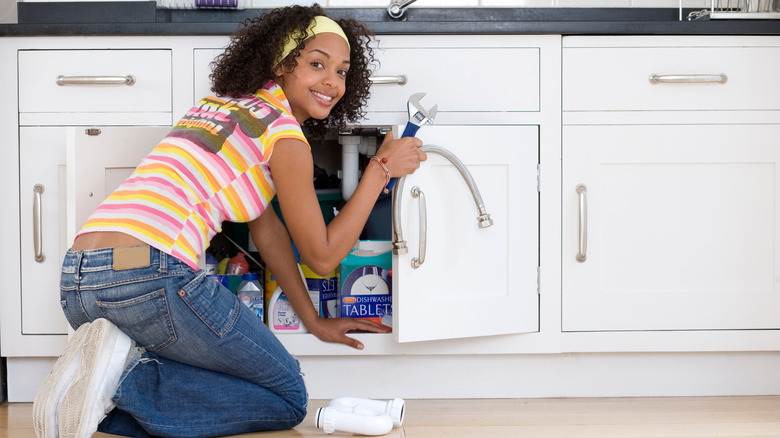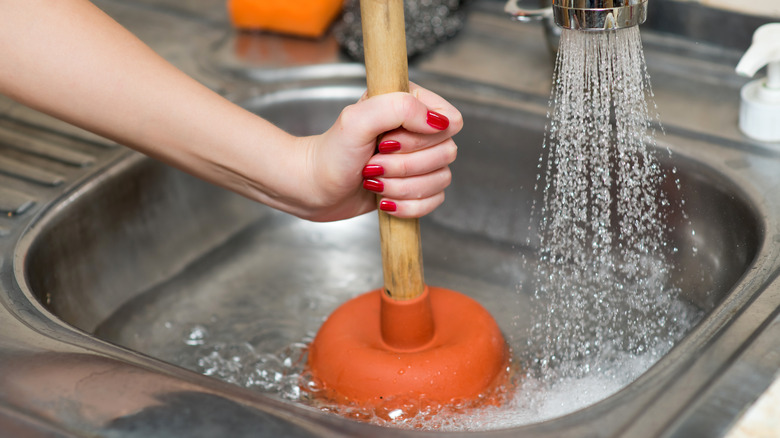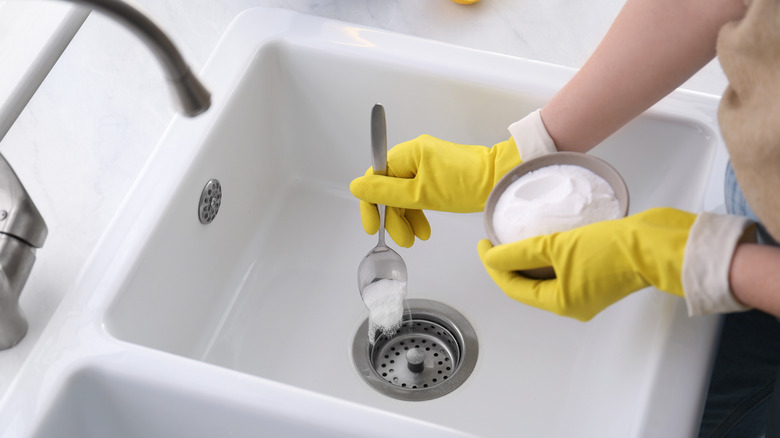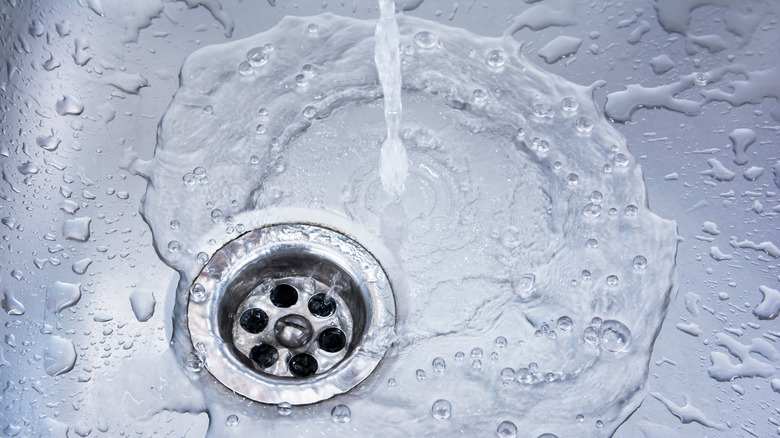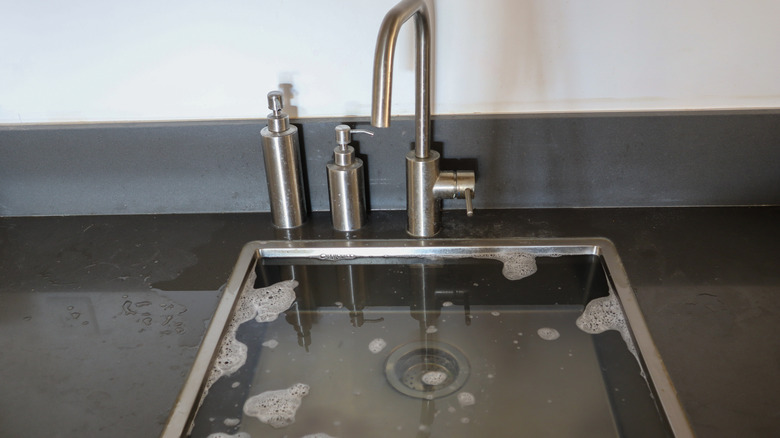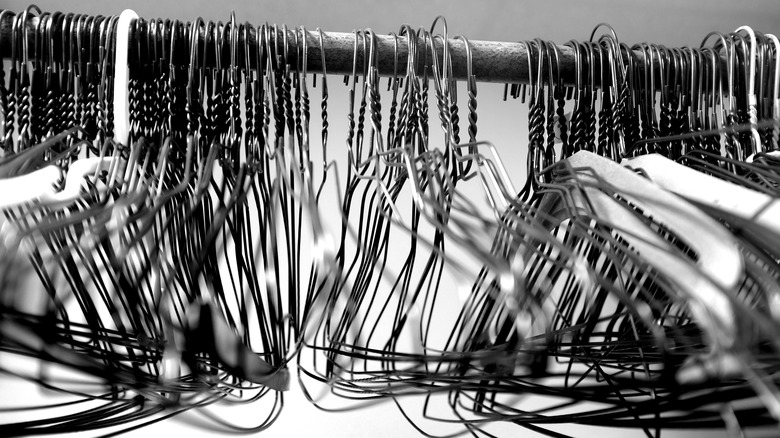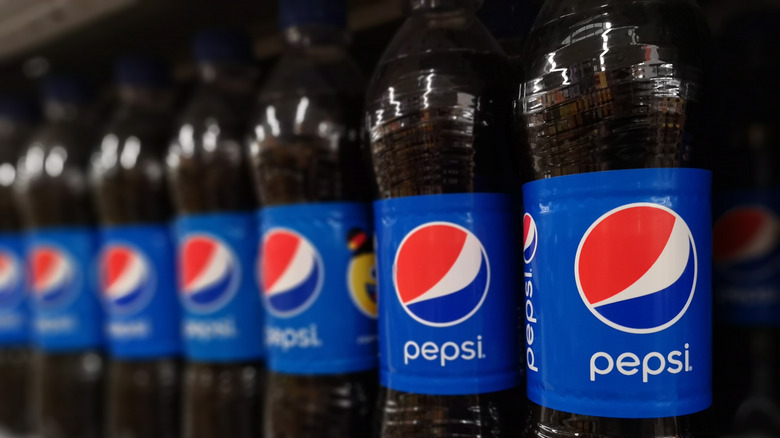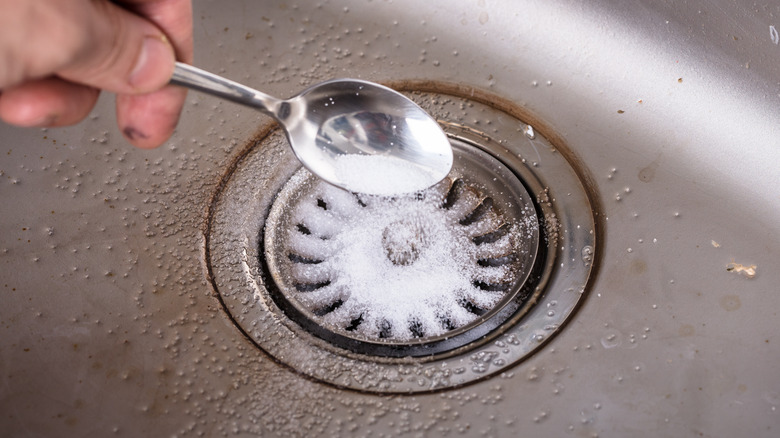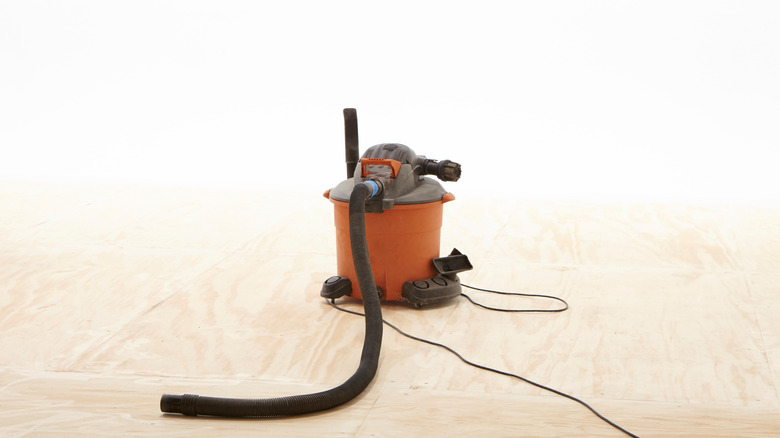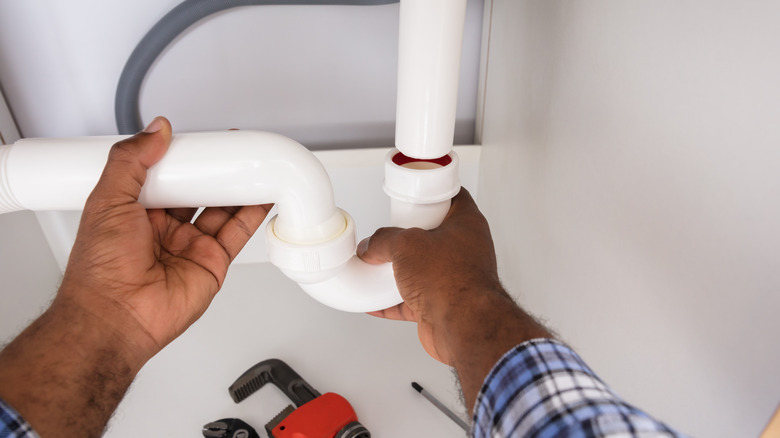10 Genius Tips For Fixing A Slow Draining Sink
The kitchen sink sees it all: the meal prep you attempted (but knew you wouldn't really eat past day two), spoon after spoon after "just one bite" of ice cream straight from the carton, the takeout leftovers you forgot about in the depths of your fridge, bacon grease that maybe should've been discarded anywhere else besides down the drain — you name it, and it's likely made its way into the garbage disposal and your kitchen plumbing.
But with the average cost for a plumber to come out and fix a clogged sink ranging from $150 to $500 as noted by Fixr, it's a wonder why we treat the sink as a catch-all. One wrong move (like dumping Brussels sprouts down the disposal), and you're bound to dip into the emergency fund for a plumber visit. Not to mention, most slow draining sinks can be handled at home before you even have to call the professionals — and you don't have to be a DIY master to give one of these hacks a shot, either!
1. Break out the plunger
First thing's first: We're talking about a sink plunger here, not a toilet plunger. If you don't have one on hand, these miniature cup plungers are available at any hardware store, aren't too expensive, and are a game changer, so keep one under your sink.
Home Depot says that the first step to addressing any clogged kitchen sink is to plunge away the problem. If there's any water in the sink because it's backed up, remove it with cups first, so that you're left with an empty basin. Add some fresh water back in with the tap, then place the plunger over the drain and get to work. This should help dislodge any gunk or food caught in the pipes, but you may need to revisit the clog with another cleaning technique to get things draining fully back up to speed.
2. Mix baking soda and vinegar
Remember those science projects from elementary school, where you mixed baking soda and vinegar to create a volcano effect, and everyone ooh'ed and aah'ed at the mess it made? We hope you took some notes, because you're going to want to break out that same technique to tackle your slow draining sink!
If you didn't, the process is straightforward: Start by pouring 1/2 cup of baking soda down the drain, and then top it off with 1/2 cup of distilled white vinegar. Let the mixture sit for about an hour with the sink drain plugged, and it'll work its magic (a little less excitingly than it did back in science class, but still — it works). You can also swap the vinegar for lemon juice, which is as acidic so it gets the job done, but it also gives your kitchen a fresh, clean scent. Afterward, run the faucet with hot water or pour boiling water down the drain to fully cleanse the pipes, per HGTV.
3. Pour in some boiling water
While boiling water makes for a great final touch to other techniques like the DIY baking soda and vinegar solution, it can also unclog a sink on its own. According to Benjamin Franklin Plumbing, you can fix a slow draining sink by heating up some water on the stove and pouring it directly down the drain. Of course, you'll have to first remove all standing water in the sink and take the proper safety precautions to avoid any hot water splattering back at you — try to wear long sleeves and keep your face away from the water when pouring it.
The only caveat to this option is that it won't work on PVC piping. As a matter of fact, it may make the situation considerably worse, warns HomeServe, since the scalding water can deteriorate the plastic pipes. Always be sure to double-check your plumbing materials before you try any of these methods!
4. Use a Zip-It tool
While the thought of leaving hot water or baking soda and vinegar to sit and unclog the drain on its own is tempting, some sinks may need some manual intervention. That's where the Zip-It comes in.
The Zip-It is a thin piece of plastic, not too far off from a zip tie, intended to work as a cheap alternative to snaking a drain. Simply remove any standing water from the sink and insert the plastic piece as far down as it will go, then pull it back up — any debris or food should either be dislodged and pushed through the pipes, or come back up when you pull out the Zip-It. Family Handyman says they cost around $5 and can be reused, but you may want to toss it depending on the level of gross gunk that comes out of your drain.
5. Repurpose a coat hanger
If you have an old wire coat hanger lying around at home (pretty likely, given that everyone in the world Marie Kondo-d their closets and opted for the no-slip velvet ones instead), you may not need to buy a Zip-It at all. Instead, use pliers to bend a coat hanger into one thin, straight piece, and then into a 90-degree angle.
National Economy Plumbers says to then carefully insert the hanger into the drain, and attempt to maneuver it in a way that dislodges the clog. If the drainage issue isn't an obstruction and is due to something else like grease buildup, you may need to scrape the edges in an upward motion to fully clean the pipe.
6. Sprinkle in Borax
Borax, a sodium tetraborate and common household cleaner, is another quick solution to a slow draining sink that you may already have on hand. According to Cooktop Cove, there are many uses for the powdered cleaner, but cleaning drains is one that rarely gets put to use — and it should be.
Instead of a DIY mixture like baking soda and lemon juice, pour 1/2 cup of Borax directly down the drain as-is. Follow it with 2 cups of scalding hot water to flush the chemical through the plumbing system. Let it sit for at least 15 minutes, and then turn on the tap — your sink should be draining like new again!
7. Let some soda sit in the sink
It might seem counterproductive to fix a slow to drain sink with more liquid, but soda's an entirely different breed. A bubbly bottle of Coca-Cola or Pepsi actually contains phosphoric acid, dissolving agents, and other chemicals strong enough to break down grease build-up or gunk blocking your drain, reveals F. H. Furr.
The company recommends dumping a 2-liter bottle of either soda directly down your drain, then leaving it for about two hours before you run the water again. For the best results, add the soda in at room temperature, rather than straight from the fridge. Any existing limescale will be wiped out after a few hours soaking in the soda, and your sink should begin draining as expected without having to break out any harsh chemical cleaners.
8. Use baking soda and cream of tartar
If you haven't yet caught on, baking soda is the key to squashing any stubborn drain issue, and there's plenty that you can pair it with to amplify its cleaning power. One of those options is cream of tartar, which is essentially just powdered tartaric acid. You probably have it up in your spice cabinet, but if not, it's easy to find at any grocery store!
Bulldog Rooter, a Washington-based plumbing service, suggests combining 1/8 cup of the powder with 1/2 cup of salt and 2 whole cups of baking soda to fight a slow draining sink. Set the dry mixture aside and pour a generous amount of boiling water down the drain, and then follow with the cream of tartar, baking soda, and salt combo. Cream of tartar is especially effective at cleaning metals, so it's a great option to try out if the vinegar or lemon juice isn't quite doing the trick.
9. Plug in your Shop Vac
Not able to flush the blockage down your kitchen sink, and it's too stubborn to come up with a Zip-It or hanger? Then it's time to break out the serious drain clearing hacks — starting with the Shop Vac. It may sound silly, but this giant appliance is actually a wet/dry vacuum, making it a useful tool to suck up any debris that may be lodged in your kitchen plumbing.
Start by completely removing your drain stopper and any water stuck in the sink. Then, insert the nozzle of the vacuum inside the drain, and pad out any gaps with a rag or dish towel — you want the opening to be airtight. Turn the vacuum on exhaust mode to get warmed up, and make note of any sound changes; you should be able to clearly hear when the clog is loosened and makes its way up the vacuum. If not, turn on suction mode and then quickly turn it back to be on exhaust mode. The effect will be like a plunger, but significantly stronger, making way for your drain to finally be cleared, according to Superior Drainage.
10. Check the pipes
If nothing seems to get your sink draining as it should be again, you may have a problem a bit deeper in the plumbing — but you can still get to it without the help of a professional, so long as you're prepared for a bit of a mess.
Home Repair Tutor notes that if you have a sink with two drains and both sides are backed up, the root of the issue is likely a clogged p-trap. The p-trap is the small curved pipe at the bottom of your kitchen sink's plumbing. It's incredibly easy for debris to get stuck there because of the angle, but it's just as simple of a fix. Be prepared with a bucket underneath the pipe, since any standing water (and all of the accompanying, old, soggy food) will immediately rush out.
Slowly loosen the top nut, and you should see a slow tricker of water, followed by a steady stream of plain grossness. Afterward, use a paper towel to fully clean the inside of the p-trap, and twist the nut back on. Hopefully, you won't have to do this one again for awhile!
